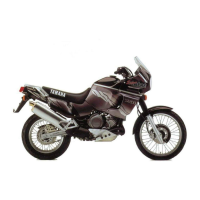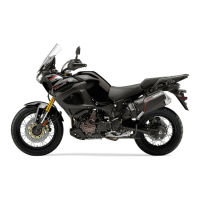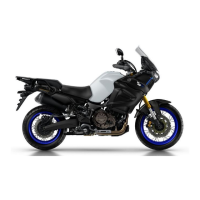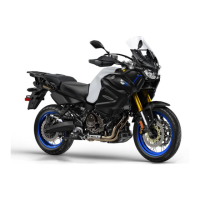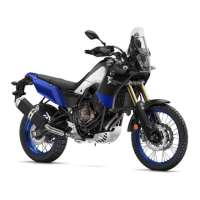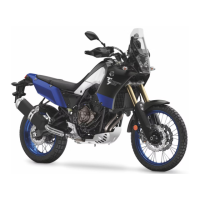Do you have a question about the Yamaha TENERE XT660ZA and is the answer not in the manual?
Read this manual carefully and completely before operating this motorcycle.
Used to alert you to potential personal injury hazards. Obey all safety messages.
Indicates a hazardous situation which, if not avoided, could result in death or serious injury.
Indicates special precautions that must be taken to avoid damage to the vehicle or other property.
Provides key information to make procedures easier or clearer.
As the owner, you are responsible for the safe and proper operation of your motorcycle.
Perform pre-operation checks and follow riding guidelines for safe operation.
Use safety helmet and protective clothing to prevent head injuries and abrasions.
Avoid engine exhaust in enclosed spaces due to deadly carbon monoxide gas.
Properly load cargo to maintain stability and avoid exceeding maximum weight limits.
Use genuine Yamaha accessories designed and tested for your vehicle for safety.
Be cautious with aftermarket parts; they may pose safety hazards or affect vehicle performance.
Use specified tires and rims for optimal performance and handling. Check tire pressure.
Follow instructions for securing the motorcycle when transporting it to prevent damage or accidents.
Diagram showing major components of the XT660Z from the left side.
Diagram showing major components of the XT660ZA from the left side.
Diagram showing major components of the XT660Z from the right side.
Diagram showing major components of the XT660ZA from the right side.
Diagram and labels for the motorcycle's main controls and instrument panel.
Explanation of the immobilizer system, keys, and operation to prevent theft.
How to use the main switch and lock the steering for security and ignition control.
Identifies and explains the function of all dashboard indicator and warning lights.
How to read the speedometer, tachometer, odometer, tripmeters, clock, and fuel meter.
Operation of left/right handlebar switches and specific function controls.
How to operate the clutch lever, shift pedal, and adjust the brake lever.
Using the brake pedal and understanding the ABS system's operation.
Procedure for opening and closing the fuel tank cap securely.
Safety guidelines for refueling, handling gasoline, and preventing fires and explosions.
Checking the breather hose and specifications for fuel tank capacity and reserve.
Information on catalytic converters and how to remove/install the seat.
How to adjust front fork (XT660Z) and rear shock absorber spring preload.
Sidestand operation and its role in the ignition cut-off system.
Explanation of the ignition circuit cut-off system's safety functions.
Procedure to verify the correct operation of the ignition circuit cut-off system.
Check fuel level, line, and engine oil level for proper operation and leaks.
Check coolant level and system, and inspect front brake operation and fluid.
Inspect rear brake, clutch operation, and throttle grip for proper function.
Check drive chain condition, slack, and inspect wheels and tires.
Check operation of pedals, levers, sidestand, and tighten chassis fasteners.
Verify the sidestand switch is functioning correctly as part of the ignition system.
Understand controls and follow safe procedures for starting the engine.
Confirm indicator lights function and learn proper gear shifting techniques.
Improve fuel economy and follow break-in procedures for engine longevity.
Operate normally after break-in and follow safe parking guidelines.
Regular maintenance ensures safety and efficiency. Use the owner's tool kit for minor repairs.
Consult a Yamaha dealer for jobs requiring special tools or expertise.
Scheduled maintenance for emission control system based on odometer readings.
Maintenance schedule for air filter, clutch, brakes, hoses, wheels, tires, bearings.
Maintenance schedule for swingarm, drive chain, steering, chassis, levers, sidestand, switches.
Maintenance schedule for front fork, shock absorber, engine oil, filter, coolant, brake switches, cables.
Maintenance schedule for lights, signals, and switches.
Instructions for removing and installing various body panels for maintenance access.
Procedure to check spark plug condition, gap, and install correctly.
How to check the engine oil level and procedures for changing oil and filter.
How to check the coolant level and procedures for changing coolant.
How to replace the air filter element and clean the check hose.
Checks for throttle cable play, valve clearance, and tire air pressure.
Guidelines for inspecting tires and checking minimum tread depth.
Approved tire models and spoke wheel precautions.
How to adjust the clutch lever free play for optimal operation.
How to check front/rear brake pad wear and front brake fluid level.
Check rear brake fluid level and procedures for changing brake fluid.
Procedure for checking and adjusting drive chain slack for proper tension.
How to clean and lubricate the drive chain using recommended lubricants.
Check and lubricate control cables and brake/clutch lever pivots.
Check and lubricate the brake pedal pivot and sidestand.
Lubricate suspension points and check front fork operation.
Check steering bearings for wear or looseness to ensure safe operation.
Check wheel bearings and battery connections for proper function.
Guidelines for charging and storing the motorcycle battery properly.
How to identify and replace blown fuses with correct amperage.
How to replace the headlight bulb safely and precautions.
If the LED tail/brake light fails, consult a dealer for inspection.
How to replace turn signal, license plate, and auxiliary light bulbs.
Methods for safely supporting the motorcycle for wheel or other maintenance.
Step-by-step instructions for removing and installing the front wheel.
Procedure for removing the rear wheel, including chain and brake caliper steps.
Instructions for installing the rear wheel, chain, and brake caliper.
Overview of troubleshooting procedures for common vehicle issues.
Guides for diagnosing and resolving starting issues or poor engine performance.
Procedure for checking coolant level and diagnosing engine overheating.
Guidelines for cleaning matte finishes and general vehicle washing.
Cleaning instructions for various conditions and applying corrosion protection.
Recommendations for storing the motorcycle properly for short or long periods.
Key specifications for dimensions, weight, engine, and fuel system.
Technical specifications for drivetrain, chassis, suspension, and brake systems.
Details on tires, wheels, suspension travel, and brake fluid.
Specifications for electrical system components, battery, lights, and fuses.
Location and importance of VIN and model label for identification and parts ordering.
Read this manual carefully and completely before operating this motorcycle.
Used to alert you to potential personal injury hazards. Obey all safety messages.
Indicates a hazardous situation which, if not avoided, could result in death or serious injury.
Indicates special precautions that must be taken to avoid damage to the vehicle or other property.
Provides key information to make procedures easier or clearer.
As the owner, you are responsible for the safe and proper operation of your motorcycle.
Perform pre-operation checks and follow riding guidelines for safe operation.
Use safety helmet and protective clothing to prevent head injuries and abrasions.
Avoid engine exhaust in enclosed spaces due to deadly carbon monoxide gas.
Properly load cargo to maintain stability and avoid exceeding maximum weight limits.
Use genuine Yamaha accessories designed and tested for your vehicle for safety.
Be cautious with aftermarket parts; they may pose safety hazards or affect vehicle performance.
Use specified tires and rims for optimal performance and handling. Check tire pressure.
Follow instructions for securing the motorcycle when transporting it to prevent damage or accidents.
Diagram showing major components of the XT660Z from the left side.
Diagram showing major components of the XT660ZA from the left side.
Diagram showing major components of the XT660Z from the right side.
Diagram showing major components of the XT660ZA from the right side.
Diagram and labels for the motorcycle's main controls and instrument panel.
Explanation of the immobilizer system, keys, and operation to prevent theft.
How to use the main switch and lock the steering for security and ignition control.
Identifies and explains the function of all dashboard indicator and warning lights.
How to read the speedometer, tachometer, odometer, tripmeters, clock, and fuel meter.
Operation of left/right handlebar switches and specific function controls.
How to operate the clutch lever, shift pedal, and adjust the brake lever.
Using the brake pedal and understanding the ABS system's operation.
Procedure for opening and closing the fuel tank cap securely.
Safety guidelines for refueling, handling gasoline, and preventing fires and explosions.
Checking the breather hose and specifications for fuel tank capacity and reserve.
Information on catalytic converters and how to remove/install the seat.
How to adjust front fork (XT660Z) and rear shock absorber spring preload.
Sidestand operation and its role in the ignition cut-off system.
Explanation of the ignition circuit cut-off system's safety functions.
Procedure to verify the correct operation of the ignition circuit cut-off system.
Check fuel level, line, and engine oil level for proper operation and leaks.
Check coolant level and system, and inspect front brake operation and fluid.
Inspect rear brake, clutch operation, and throttle grip for proper function.
Check drive chain condition, slack, and inspect wheels and tires.
Check operation of pedals, levers, sidestand, and tighten chassis fasteners.
Verify the sidestand switch is functioning correctly as part of the ignition system.
Understand controls and follow safe procedures for starting the engine.
Confirm indicator lights function and learn proper gear shifting techniques.
Improve fuel economy and follow break-in procedures for engine longevity.
Operate normally after break-in and follow safe parking guidelines.
Regular maintenance ensures safety and efficiency. Use the owner's tool kit for minor repairs.
Consult a Yamaha dealer for jobs requiring special tools or expertise.
Scheduled maintenance for emission control system based on odometer readings.
Maintenance schedule for air filter, clutch, brakes, hoses, wheels, tires, bearings.
Maintenance schedule for swingarm, drive chain, steering, chassis, levers, sidestand, switches.
Maintenance schedule for front fork, shock absorber, engine oil, filter, coolant, brake switches, cables.
Maintenance schedule for lights, signals, and switches.
Instructions for removing and installing various body panels for maintenance access.
Procedure to check spark plug condition, gap, and install correctly.
How to check the engine oil level and procedures for changing oil and filter.
How to check the coolant level and procedures for changing coolant.
How to replace the air filter element and clean the check hose.
Checks for throttle cable play, valve clearance, and tire air pressure.
Guidelines for inspecting tires and checking minimum tread depth.
Approved tire models and spoke wheel precautions.
How to adjust the clutch lever free play for optimal operation.
How to check front/rear brake pad wear and front brake fluid level.
Check rear brake fluid level and procedures for changing brake fluid.
Procedure for checking and adjusting drive chain slack for proper tension.
How to clean and lubricate the drive chain using recommended lubricants.
Check and lubricate control cables and brake/clutch lever pivots.
Check and lubricate the brake pedal pivot and sidestand.
Lubricate suspension points and check front fork operation.
Check steering bearings for wear or looseness to ensure safe operation.
Check wheel bearings and battery connections for proper function.
Guidelines for charging and storing the motorcycle battery properly.
How to identify and replace blown fuses with correct amperage.
How to replace the headlight bulb safely and precautions.
If the LED tail/brake light fails, consult a dealer for inspection.
How to replace turn signal, license plate, and auxiliary light bulbs.
Methods for safely supporting the motorcycle for wheel or other maintenance.
Step-by-step instructions for removing and installing the front wheel.
Procedure for removing the rear wheel, including chain and brake caliper steps.
Instructions for installing the rear wheel, chain, and brake caliper.
Overview of troubleshooting procedures for common vehicle issues.
Guides for diagnosing and resolving starting issues or poor engine performance.
Procedure for checking coolant level and diagnosing engine overheating.
Guidelines for cleaning matte finishes and general vehicle washing.
Cleaning instructions for various conditions and applying corrosion protection.
Recommendations for storing the motorcycle properly for short or long periods.
Key specifications for dimensions, weight, engine, and fuel system.
Technical specifications for drivetrain, chassis, suspension, and brake systems.
Details on tires, wheels, suspension travel, and brake fluid.
Specifications for electrical system components, battery, lights, and fuses.
Location and importance of VIN and model label for identification and parts ordering.
| Displacement | 660 cc |
|---|---|
| Bore x Stroke | 100.0 mm x 84.0 mm |
| Compression Ratio | 10.0 : 1 |
| Lubrication System | Wet sump |
| Fuel System | Fuel Injection |
| Ignition System | TCI |
| Starter System | Electric |
| Final Transmission | Chain |
| Front Tyre | 90/90-21 |
| Overall Width | 865 mm |
| Seat Height | 895 mm |
| Wheel Base | 1, 505 mm |
| Engine Type | Liquid-cooled, 4-stroke, 4-valve |
| Maximum Power | 48 hp (35 kW) @ 6, 000 rpm |
| Maximum Torque | 58.0 Nm (5.9 kg-m) @ 5, 250 rpm |
| Transmission System | 5-speed |
| Frame | Steel |
| Front Suspension | Telescopic forks |
| Rear Suspension | Monoshock |
| Front Brake | Single 298 mm disc, 2-piston caliper |
| Rear Brake | Disc, 245 mm |
| Rear Tyre | 130/80-17 |

